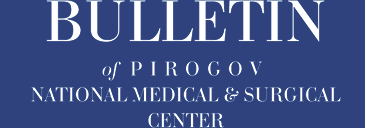Authors
Dovnar R.I.1, Fedzianin S.D.2, Okulich V.K.2, Konopelko E.A.3, Stavchikov E.L.2, 4
1 Grodno State Medical University, Grodno, Belarus
2 Vitebsk State Order of Peoples’ Friendship Medical University, Vitebsk, Belarus
3 Vitebsk Regional Clinical Hospital, Vitebsk, Belarus
4 Mogilev Regional Clinical Hospital, Mogilev, Belarus
Abstract
Aims: To compare the etiological structure of pathogens in patients with purulent wounds in hospitals in Grodno and Vitebsk.
Methods: The analysis of the results of microbiological studies in patients with purulent wounds who were treated at the Municipal Clinical Hospital of Emergency Medicine of Grodno and the Vitebsk Regional Clinical Hospital in 2016-2023 was performed. A complex of bacteriological studies has been carried out. The species was determined on the ATB Expression BioMerieux biochemical analyzer (France).
Results: The analysis of the seeded microflora in patients with purulent wounds in hospitals in Grodno and Vitebsk showed that the leading role as an etiological factor is occupied by representatives of the genus Staphylococcus, the family Enterobacteriaceae, P. aeruginosа and A. baumannii. K. pneumoniae is the leader among enterobacteria. Сoagulase-negative staphylococci and enterobacteria are more common in Grodno, and P. aeruginosа and A. baumannii are more common in Vitebsk. ESKAPE pathogens predominate in Vitebsk.
Conclusion: In different regions of the Republic of Belarus, there are individual differences in the species structure of pathogens of purulent processes of soft tissues, however, in general, there is a general tendency for the growth of the most dangerous pathogens of the “ESKAPE pathogen” group for patients. This indicates a gradual decrease in the effectiveness of antibiotic therapy, which dictates the need to search for new means of combating such microorganisms, one of the variants of which may be metal nanoparticles.
Keywords: microbial flora, purulent wounds, infection, resistance, antibiotics.
References
1. Hajtovich AB, Voevodkina AYu. Mikrobiom i ego vliyanie na zdorov’e cheloveka. Krymskij zhurnal eksperimental’noj i klinicheskoj mediciny. 2019; 9(1): 61-70. (In Russ.)
2. Vorob’eva ON, et al. Analiz etiologicheskoj struktury i chuvstvitel’nosti k antibiotikam vozbuditelej infekcij, svyazannyh s okazaniem medicinskoj pomoshchi, v hirurgicheskih stacionarah. Medicina v Kuzbasse. 2022; 21(3): 19-26. (In Russ.)
3. Evdokimova NV, et al. Spektr vozbuditelej oslozhnennyh abdominal’nyh infekcij u pacientov hirurgicheskogo profilya. Zhurnal im. N. V. Sklifosovskogo “Neotlozhnaya medicinskaya pomoshch’”. 2023; 12(1): 51-56. (In Russ.)
4. Bandy A, Wani FA, Mohammed AH, et al. Bacteriological profile of wound infections and antimicrobial resistance in selected gram-negative bacteria. African health sciences. 2022; 22(4): 576-586. doi: 10.4314/ahs.v22i4.63.
5. Bouza E, Burillo A. Current international and national guidelines for managing skin and soft tissue infections. Current opinion in infectious diseases. 2022; 35(2): 61-71. doi: 10.1097/QCO.0000000000000814.
6. Blanes HR, Rodríguez PM, Fernández NJ, Salavert LM. Current approach to skin and soft tissue infections. Thinking about continuity of care. Rev Esp Quimioter. 2023; 36(1): 37-45. doi: 10.37201/req/s01.10.2023.
7. Farzin A, Rahman MM, Mollika FA, et al. Bacteriological Profile of Hospital Acquired Infection and Their Antimicrobial Susceptibility Patterns in a Tertiary Care Hospital. Mymensingh Med J. 2023; 32(3): 787-793.
8. Shipicyna IV, Osipova EV. Monitoring vedushchej grampolozhitel’noj mikroflory i ee antibiotikochuvstvitel’nosti u lic s hronicheskim osteomielitom za trekhletnij period. Genij ortopedii. 2022; 28(2): 189-193. (In Russ.)
9. Jasemi S, Douraghi M, Adibhesami H, et al. Trend of extensively drug-resistant Acinetobacter baumannii and the remaining therapeutic options: a multicenter study in Tehran, Iran over a 3-year period. Lett Appl Microbiol. 2017; 63(6): 466-72. doi: 10.1111/lam.12669.
10. Gillespie BM, Harbeck E, Rattray M. Worldwide incidence of surgical site infections in general surgical patients: A systematic review and meta-analysis of 488,594 patients. Int J Surg. 2021; 95: 106136. doi: 10.1016/ j.ijsu.2021.106136.
11. Zemlyanoj AB, Zelenina TA, Saluhov VV. Paralleli osobennostej antibiotikorezistentnosti infekcij sindroma diabeticheskoj stopy na stacionarnom i ambulatornom etapah lecheniya. Medicinskij sovet. 2022; 16(6): 234-242. (In Russ.)
12. Al’-Kanani ESH, et al. Infekcionnye oslozhneniya posle planovyh operacij v mnogoprofil’nom stacionare. Aktual’nye problemy mediciny. 2024; 47(1): 99-118. (In Russ.)
13. Dovnar RI, et al. Nanochasticy medi i selena kak novoe sredstvo bor’by s antibiotikorezistentnymi patogennymi mikroorganizmami. Hirurgiya. Vostochnaya Evropa. 2022; 11(3): 315-328. (In Russ.)
14. Aubakirova AT, et al. Mikrobiologicheskij monitoring vnutribol’nichnoj infekcii v hirurgicheskom stacionare. Vestnik Kazahskogo Nacional’nogo medicinskogo universiteta. 2021; 3: 235-239. (In Russ.)


